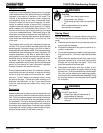
Page 46
433-1390D
September 7, 2007
R
7100FP EPA Woodburning Fireplace
F. Blower Operation
Instructions with Blower Override Switch in manual posi-
tion.
NOTE: The blower is equipped with a snap disc that will turn
the blower on and off depending on the temperature of the
fi replace. If the blower is not coming on at the desired time,
fl ip the override switch to manual and operate the blower as
described above.
The override switch and the blower speed control are hard
wired at time of installation and installed in a standard wall
mount with junction box on the wall.
G. Heat Zone Operation
The Heat-Zone accessory kit conveys warm air from the
fi replace through air duct(s) to remote locations in the same
room or other rooms of the building. You may install 1 or
2 Heat-Zone kits on the fi replace. Follow the instructions
that is supplied with the kit. Installation of this kit MUST be
performed by a qualifi ed service technician. If any parts are
missing or damaged, contact your local dealer before starting
installation. DO NOT install a damaged kit.
The Heat-Zone kit is carefully engineered and must be
installed only as specifi ed. If you modify it or any of its com-
ponents, you will void the warranty and you may possibly
cause a fi re hazard. Installation must be done according to
applicable local, state, provincial, and/or national codes.
CAUTION
ALL wiring should be done by a qualifi ed electrician and
shall be in compliance with local codes and with the National
Electric Code NFPA/NEC No. 70-current (in the United
States), or with the current CSC22.1 Canadian Electric
Code (in Canada).
DUCT RUN REQUIREMENTS
MAXIMUM Duct Run = 40 ft. (12m)
MINIMUM Duct Run = 36 in. (914mm)
DUCTING MATERIAL
6 in. (152mm) B-Vent Only
DO NOT DUCT into existing furnace plenum
MINIMUM CLEARANCE TO COMBUSTIBLE
1 in. (25mm) from the B-Vent
1/2 in. (13mm) from top and bottom of outlet box
0 in. (0mm) from the sides of outlet box
12 in. (305mm) from wall register to ceiling
H. Wood Fuel
Hardwood vs. Softwood
Your fi replace’s performance depends a great deal on
the quality of the fi rewood you use. Contrary to popular
belief, one species of wood varies very little to the other in
terms of energy content. All seasoned wood, regardless
of species, contains about 8,000 BTU’s per pound. The
important factor is that hardwoods have a greater density
than softwoods. Therefore, a piece of hardwood will con-
tain about 60% more BTU’s than an equal size piece of
softwood. Since fi rewood is commonly sold by the cord
(128 cu. ft) a volume measurement, a cord of seasoned
oak (hardwood) would contain about 60% more potential
energy than a cord of seasoned pine (softwood).
There are many defi nitions of hardwood and softwood.
Although not true in every case, one of the most reli-
able is to classify them as coniferous or deciduous.
Softwoods are considered coniferous. These are trees
with needle-like leaves that stay green all year and carry
their seeds exposed in a cone. Examples of softwood
trees are Douglas fi r, pine, spruce and cedar. Softwoods,
being more porous, require less time to dry, burn faster
and are easier to ignite than hardwoods. Deciduous
trees are broadleaf trees that lose their leaves in the fall.
Their seeds are usually found within a protective pod
or enclosure. Hardwoods fall into this category. Some
examples of deciduous trees are oak, maple, apple,
and birch. However, it should be noted that there are
some deciduous trees that are defi nitely not considered
hardwoods such as poplar, aspen and alder. Hardwoods
require more time to season, burn slower and are usually
harder to ignite than softwoods. Obviously, you will use
the type of wood that is most readily available in your
area. However, if at all possible the best arrangement is
to have a mix of softwood and hardwood. This way you
can use the softwood for starting the fi re giving off quick
heat to bring the appliance up to operating temperature.
Then add the hardwood for slow, even heat and longer
burn time.
1. Initial (cold) Startup: Leave blower off until your fi re-
place is hot and a good coal bed is established, ap-
proximately 30 minutes after fuel is lit.
2. High Burn Setting: The blower may be left on
throughout the burn.
3. Medium or Medium High Burn Setting: The blower
should be left off until a good burn is established, then
turned on medium or high rate.
4. Low Burn Setting: The blower tends to cool off the
fi replace. Leave blower off until the burn is well estab-
lished; then, if you wish, turn the blower on at a low
rate.


















